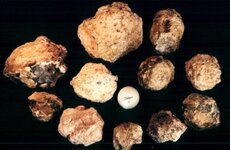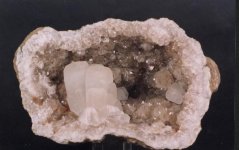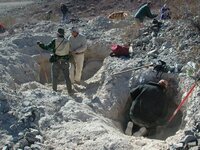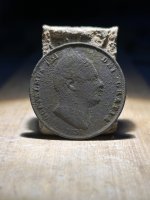pegleglooker
Bronze Member
- Jun 9, 2006
- 1,857
- 237
- Detector(s) used
- ace 250
- Primary Interest:
- All Treasure Hunting
I think I " may " go to this place sometime this month. Has anyone been there?? Anybody have any advice ??
PLL
Rockhounding At The
Hauser Geode Beds
By Lynn M. Bremner
On a recent trip to the Hauser Geode Beds, memories of my first visit to the area came to mind. I was 12 years old the first time I went geode hunting with my family. My father had learned about the Hauser Geode Beds from an old timer who frequently rockhounded there. He told my father we could easily find the famous Hauser Geode Beds by driving East on Interstate 10 through the Coachella Valley until we saw a sign pointing the way to the geodes. The old timer said we would know we were there when we saw geodes abundantly scattered upon the ground. You can imagine how excited we were to have learned of such a location.
Sounded like a fairly easy find, so my father packed us up into his 4x4 Jeep, and we headed eastbound on Interstate 10. After a tiresome search for the geode sign, we finally decided to stop an ask a local gas station attendant if he knew where the Hauser Geode Beds were located. It didn't take long to jot down yet another simple set of directions which lead us to Wiley Well Road. Exit and down a washboard dirt road toward Wiley Well and Coon Hollow Campground.
After a few hours of unsuccessful exploration down unmarked dirt roads, we finally found the Hauser Geode Beds. It was only an hour until sunset, and a lone prospector who had been digging all day was packing his gear to leave. He was kind enough to show us the hole where he had found buckets full of fist-sized geodes, and even took a few minutes to show us how to extract them.

The prospector explained that geodes are found in groups located in volcanic ash beds, which is why they are referred to as Geode Beds. He showed us sample geodes from his bucket so we could easily identify them. At first glance, the geodes look like sphere-shaped, brown muddy rocks and can easily blend in with the landscape. They are lighter in color than the darker varnished rocks which cover the land surrounding the geode beds, so they can easily be identified once you know what to look for. Geodes vary in size, some are as small as a cherry and others as large as a grapefruit.
We thanked the prospector for his help and began to dig. The excitement was overwhelming, and the tedious hours we spent searching for the geode beds was forgotten in the thrill of our discovery. While my brother quickly and eagerly dug out the geodes, my father and I cracked a few open to discover beautiful crystals inside. It was a moment of pure delight.
We left the Hauser Geode Beds with a bucket full of geodes and huge smiles. It was the first of many successful rockhounding trips to Wiley Well. Every Thanksgiving we returned to Coon Hollow at Wiley Well to camp and search the desert floor for geodes and other rocks and minerals. Although I never forgot the excitement of the first geode expedition, I still feel a charge of mystery and anticipation each time we revisit the Hauser Geode Beds and the Potato Patch, another nearby collecting site.

Although our annual Thanksgiving trips to the Hauser Geode Beds have subsided, during a recent visit there I found myself digging in the volcanic ash beds with the same enthusiasm I had experienced 18 years ago. Cautiously,. I tapped around an embedded geode with my pick. Each strike loosened the geode a little more from its thousand-year resting place. Finally, the geode fell into my hand, and I eagerly broke it open to discover its contents. To my disappointment the geode did not contain any crystals, so I continued to dig and search for the next one.
Notes On The Hauser Geode Beds
Location: Take Wiley Well Road Exit from Interstate 10 and continue driving south on the graded dirt road (also called MO58 on the BLM Access Guide # 21). You will pass Wiley Well Campground (9 miles south of I-10), Coon Hollow Campground (12 miles south of 1I-0). Next you will see a dirt road on the right with BLM MO51 marker indicating the route to the Hauser Geode Beds. Continue on MO51 until you encounter BLM marker MO42 which bears left; then bear left again on MO43. Keep your eyes open for diggings on the hill sides, which will indicate the Hauser Geode Beds.
The prospector explained that geodes are found in groups located in volcanic ash beds, which is why they are referred to as Geode Beds. He showed us sample geodes from his bucket so we could easily identify them. At first glance, the geodes look like sphere-shaped, brown muddy rocks and can easily blend in with the landscape. They are lighter in color than the darker varnished rocks which cover the land surrounding the geode beds, so they can easily be identified once you know what to look for. Geodes vary in size, some are as small as a cherry and others as large as a grapefruit.
We thanked the prospector for his help and began to dig. The excitement was overwhelming, and the tedious hours we spent searching for the geode beds was forgotten in the thrill of our discovery. While my brother quickly and eagerly dug out the geodes, my father and I cracked a few open to discover beautiful crystals inside. It was a moment of pure delight.
We left the Hauser Geode Beds with a bucket full of geodes and huge smiles. It was the first of many successful rockhounding trips to Wiley Well. Every Thanksgiving we returned to Coon Hollow at Wiley Well to camp and search the desert floor for geodes and other rocks and minerals. Although I never forgot the excitement of the first geode expedition, I still feel a charge of mystery and anticipation each time we revisit the Hauser Geode Beds and the Potato Patch, another nearby collecting site.
Although our annual Thanksgiving trips to the Hauser Geode Beds have subsided, during a recent visit there I found myself digging in the volcanic ash beds with the same enthusiasm I had experienced 18 years ago. Cautiously,. I tapped around an embedded geode with my pick. Each strike loosened the geode a little more from its thousand-year resting place. Finally, the geode fell into my hand, and I eagerly broke it open to discover its contents. To my disappointment the geode did not contain any crystals, so I continued to dig and search for the next one.
Notes On The Hauser Geode Beds
Location: Take Wiley Well Road Exit from Interstate 10 and continue driving south on the graded dirt road (also called MO58 on the BLM Access Guide # 21). You will pass Wiley Well Campground (9 miles south of I-10), Coon Hollow Campground (12 miles south of 1I-0). Next you will see a dirt road on the right with BLM MO51 marker indicating the route to the Hauser Geode Beds. Continue on MO51 until you encounter BLM marker MO42 which bears left; then bear left again on MO43. Keep your eyes open for diggings on the hill sides, which will indicate the Hauser Geode Beds.
Notes On The Hauser Geode Beds
Location: Take Wiley Well Road Exit from Interstate 10 and continue driving south on the graded dirt road (also called MO58 on the BLM Access Guide # 21). You will pass Wiley Well Campground (9 miles south of I-10), Coon Hollow Campground (12 miles south of 1I-0). Next you will see a dirt road on the right with BLM MO51 marker indicating the route to the Hauser Geode Beds. Continue on MO51 until you encounter BLM marker MO42 which bears left; then bear left again on MO43. Keep your eyes open for diggings on the hill sides, which will indicate the Hauser Geode Beds. Notes On The Hauser Geode Beds
Location: Take Wiley Well Road Exit from Interstate 10 and continue driving south on the graded dirt road (also called MO58 on the BLM Access Guide # 21). You will pass Wiley Well Campground (9 miles south of I-10), Coon Hollow Campground (12 miles south of 1I-0). Next you will see a dirt road on the right with BLM MO51 marker indicating the route to the Hauser Geode Beds. Continue on MO51 until you encounter BLM marker MO42 which bears left; then bear left again on MO43. Keep your eyes open for diggings on the hill sides, which will indicate the Hauser Geode Beds.
PLL
Rockhounding At The
Hauser Geode Beds
By Lynn M. Bremner
On a recent trip to the Hauser Geode Beds, memories of my first visit to the area came to mind. I was 12 years old the first time I went geode hunting with my family. My father had learned about the Hauser Geode Beds from an old timer who frequently rockhounded there. He told my father we could easily find the famous Hauser Geode Beds by driving East on Interstate 10 through the Coachella Valley until we saw a sign pointing the way to the geodes. The old timer said we would know we were there when we saw geodes abundantly scattered upon the ground. You can imagine how excited we were to have learned of such a location.
Sounded like a fairly easy find, so my father packed us up into his 4x4 Jeep, and we headed eastbound on Interstate 10. After a tiresome search for the geode sign, we finally decided to stop an ask a local gas station attendant if he knew where the Hauser Geode Beds were located. It didn't take long to jot down yet another simple set of directions which lead us to Wiley Well Road. Exit and down a washboard dirt road toward Wiley Well and Coon Hollow Campground.
After a few hours of unsuccessful exploration down unmarked dirt roads, we finally found the Hauser Geode Beds. It was only an hour until sunset, and a lone prospector who had been digging all day was packing his gear to leave. He was kind enough to show us the hole where he had found buckets full of fist-sized geodes, and even took a few minutes to show us how to extract them.

The prospector explained that geodes are found in groups located in volcanic ash beds, which is why they are referred to as Geode Beds. He showed us sample geodes from his bucket so we could easily identify them. At first glance, the geodes look like sphere-shaped, brown muddy rocks and can easily blend in with the landscape. They are lighter in color than the darker varnished rocks which cover the land surrounding the geode beds, so they can easily be identified once you know what to look for. Geodes vary in size, some are as small as a cherry and others as large as a grapefruit.
We thanked the prospector for his help and began to dig. The excitement was overwhelming, and the tedious hours we spent searching for the geode beds was forgotten in the thrill of our discovery. While my brother quickly and eagerly dug out the geodes, my father and I cracked a few open to discover beautiful crystals inside. It was a moment of pure delight.
We left the Hauser Geode Beds with a bucket full of geodes and huge smiles. It was the first of many successful rockhounding trips to Wiley Well. Every Thanksgiving we returned to Coon Hollow at Wiley Well to camp and search the desert floor for geodes and other rocks and minerals. Although I never forgot the excitement of the first geode expedition, I still feel a charge of mystery and anticipation each time we revisit the Hauser Geode Beds and the Potato Patch, another nearby collecting site.

Although our annual Thanksgiving trips to the Hauser Geode Beds have subsided, during a recent visit there I found myself digging in the volcanic ash beds with the same enthusiasm I had experienced 18 years ago. Cautiously,. I tapped around an embedded geode with my pick. Each strike loosened the geode a little more from its thousand-year resting place. Finally, the geode fell into my hand, and I eagerly broke it open to discover its contents. To my disappointment the geode did not contain any crystals, so I continued to dig and search for the next one.
Notes On The Hauser Geode Beds
Location: Take Wiley Well Road Exit from Interstate 10 and continue driving south on the graded dirt road (also called MO58 on the BLM Access Guide # 21). You will pass Wiley Well Campground (9 miles south of I-10), Coon Hollow Campground (12 miles south of 1I-0). Next you will see a dirt road on the right with BLM MO51 marker indicating the route to the Hauser Geode Beds. Continue on MO51 until you encounter BLM marker MO42 which bears left; then bear left again on MO43. Keep your eyes open for diggings on the hill sides, which will indicate the Hauser Geode Beds.
The prospector explained that geodes are found in groups located in volcanic ash beds, which is why they are referred to as Geode Beds. He showed us sample geodes from his bucket so we could easily identify them. At first glance, the geodes look like sphere-shaped, brown muddy rocks and can easily blend in with the landscape. They are lighter in color than the darker varnished rocks which cover the land surrounding the geode beds, so they can easily be identified once you know what to look for. Geodes vary in size, some are as small as a cherry and others as large as a grapefruit.
We thanked the prospector for his help and began to dig. The excitement was overwhelming, and the tedious hours we spent searching for the geode beds was forgotten in the thrill of our discovery. While my brother quickly and eagerly dug out the geodes, my father and I cracked a few open to discover beautiful crystals inside. It was a moment of pure delight.
We left the Hauser Geode Beds with a bucket full of geodes and huge smiles. It was the first of many successful rockhounding trips to Wiley Well. Every Thanksgiving we returned to Coon Hollow at Wiley Well to camp and search the desert floor for geodes and other rocks and minerals. Although I never forgot the excitement of the first geode expedition, I still feel a charge of mystery and anticipation each time we revisit the Hauser Geode Beds and the Potato Patch, another nearby collecting site.
Although our annual Thanksgiving trips to the Hauser Geode Beds have subsided, during a recent visit there I found myself digging in the volcanic ash beds with the same enthusiasm I had experienced 18 years ago. Cautiously,. I tapped around an embedded geode with my pick. Each strike loosened the geode a little more from its thousand-year resting place. Finally, the geode fell into my hand, and I eagerly broke it open to discover its contents. To my disappointment the geode did not contain any crystals, so I continued to dig and search for the next one.
Notes On The Hauser Geode Beds
Location: Take Wiley Well Road Exit from Interstate 10 and continue driving south on the graded dirt road (also called MO58 on the BLM Access Guide # 21). You will pass Wiley Well Campground (9 miles south of I-10), Coon Hollow Campground (12 miles south of 1I-0). Next you will see a dirt road on the right with BLM MO51 marker indicating the route to the Hauser Geode Beds. Continue on MO51 until you encounter BLM marker MO42 which bears left; then bear left again on MO43. Keep your eyes open for diggings on the hill sides, which will indicate the Hauser Geode Beds.
Notes On The Hauser Geode Beds
Location: Take Wiley Well Road Exit from Interstate 10 and continue driving south on the graded dirt road (also called MO58 on the BLM Access Guide # 21). You will pass Wiley Well Campground (9 miles south of I-10), Coon Hollow Campground (12 miles south of 1I-0). Next you will see a dirt road on the right with BLM MO51 marker indicating the route to the Hauser Geode Beds. Continue on MO51 until you encounter BLM marker MO42 which bears left; then bear left again on MO43. Keep your eyes open for diggings on the hill sides, which will indicate the Hauser Geode Beds. Notes On The Hauser Geode Beds
Location: Take Wiley Well Road Exit from Interstate 10 and continue driving south on the graded dirt road (also called MO58 on the BLM Access Guide # 21). You will pass Wiley Well Campground (9 miles south of I-10), Coon Hollow Campground (12 miles south of 1I-0). Next you will see a dirt road on the right with BLM MO51 marker indicating the route to the Hauser Geode Beds. Continue on MO51 until you encounter BLM marker MO42 which bears left; then bear left again on MO43. Keep your eyes open for diggings on the hill sides, which will indicate the Hauser Geode Beds.







